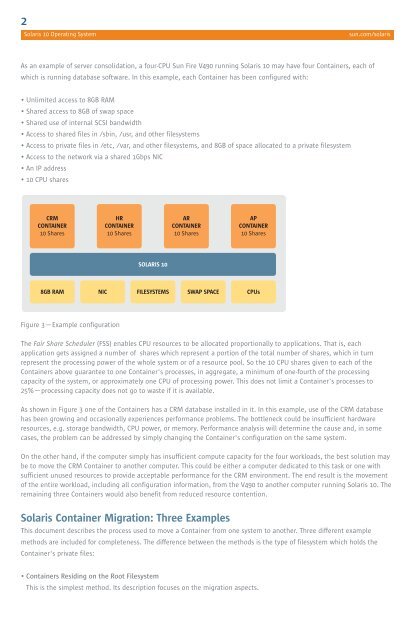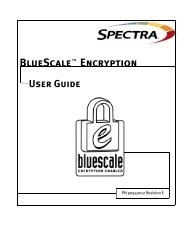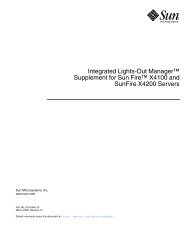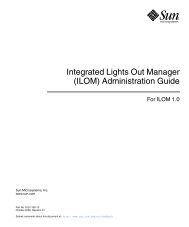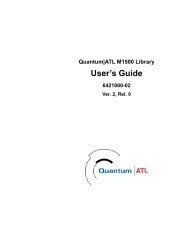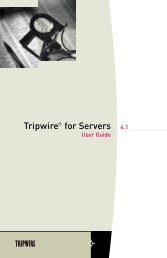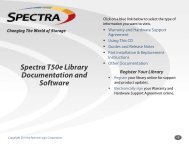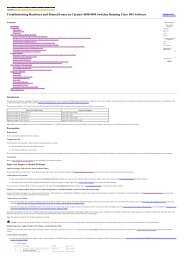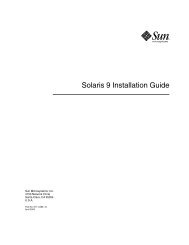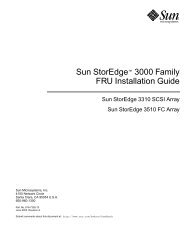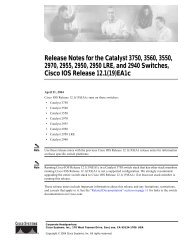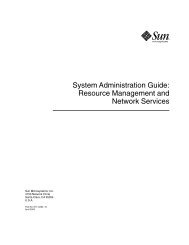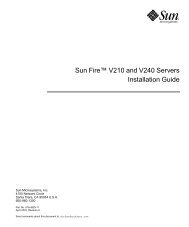A SOLARIS™ CONTAINER
A SOLARIS™ CONTAINER
A SOLARIS™ CONTAINER
Create successful ePaper yourself
Turn your PDF publications into a flip-book with our unique Google optimized e-Paper software.
2Solaris 10 Operating Systemsun.com/solarisAs an example of server consolidation, a four-CPU Sun Fire V490 running Solaris 10 may have four Containers, each ofwhich is running database software. In this example, each Container has been configured with:• Unlimited access to 8GB RAM• Shared access to 8GB of swap space• Shared use of internal SCSI bandwidth• Access to shared files in /sbin, /usr, and other filesystems• Access to private files in /etc, /var, and other filesystems, and 8GB of space allocated to a private filesystem• Access to the network via a shared 1Gbps NIC• An IP address• 10 CPU sharesCRM<strong>CONTAINER</strong>10 SharesHR<strong>CONTAINER</strong>10 SharesAR<strong>CONTAINER</strong>10 SharesAP<strong>CONTAINER</strong>10 SharesSOLARIS 108GB RAM NIC FILESYSTEMS SWAP SPACE CPUsFigure 3—Example configurationThe Fair Share Scheduler (FSS) enables CPU resources to be allocated proportionally to applications. That is, eachapplication gets assigned a number of shares which represent a portion of the total number of shares, which in turnrepresent the processing power of the whole system or of a resource pool. So the 10 CPU shares given to each of theContainers above guarantee to one Container's processes, in aggregate, a minimum of one-fourth of the processingcapacity of the system, or approximately one CPU of processing power. This does not limit a Container's processes to25%—processing capacity does not go to waste if it is available.As shown in Figure 3 one of the Containers has a CRM database installed in it. In this example, use of the CRM databasehas been growing and occasionally experiences performance problems. The bottleneck could be insufficient hardwareresources, e.g. storage bandwidth, CPU power, or memory. Performance analysis will determine the cause and, in somecases, the problem can be addressed by simply changing the Container's configuration on the same system.On the other hand, if the computer simply has insufficient compute capacity for the four workloads, the best solution maybe to move the CRM Container to another computer. This could be either a computer dedicated to this task or one withsufficient unused resources to provide acceptable performance for the CRM environment. The end result is the movementof the entire workload, including all configuration information, from the V490 to another computer running Solaris 10. Theremaining three Containers would also benefit from reduced resource contention.Solaris Container Migration: Three ExamplesThis document describes the process used to move a Container from one system to another. Three different examplemethods are included for completeness. The difference between the methods is the type of filesystem which holds theContainer's private files:• Containers Residing on the Root FilesystemThis is the simplest method. Its description focuses on the migration aspects.


